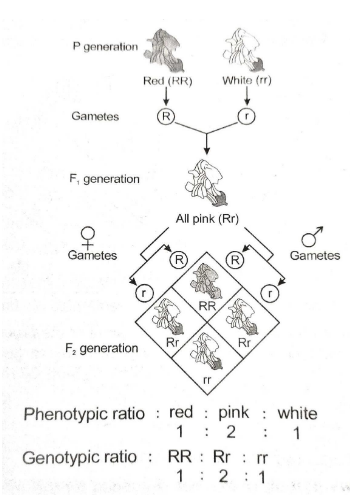
Explain incomplete dominance with example.
Answer
570.6k+ views
Hint: On the basis of Mendel observations on monohybrid cross, Mendel proposed two general rules. Today these rules are called the principles or Laws of Inheritance: the first law or Law of Dominance and the second law or Law of Segregation but there are some exceptions to these principles such as incomplete dominance.
Complete answer:
Incomplete Dominance: After Mendelism, a few cases were observed where $\mathop F\nolimits_1 $ phenotype is intermediate between dominant and recessive phenotype, it means $\mathop F\nolimits_1 $, did not resemble either of the two parents and was in between the two.
A good example of incomplete dominance is that of flower colour in Snapdragon (dog flower or Antirrhinum majus)
True-breeding red-flowered plants (RR) were crossed with true breeding white-flowered plants (rr).
$\mathop F\nolimits_1 $ offspring (Rr) had pink flowers. Here one allele is incompletely dominant over another so that intermediate phenotype is produced by $\mathop F\nolimits_1 $ hybrid with respect to the parents. If the $\mathop F\nolimits_1 $ is selfed, the plants of $\mathop F\nolimits_2 $ generation are of three types red (RR), pink (Rr) and white flowered (rr) in the ratio of 1: 2:1.
In heterozygous condition (Rr), the phenotypic effect of one allele is more pronounced than that of another and then mixing of both colours (red & white) results in the development of pink colour.
Therefore, dominance is not an autonomous feature of a gene or the product. It depends upon the gene product and particular phenotype we choose to examine when a gene produces more than one phenotype
In phenylketonuria, mutation of a gene that codes for the enzyme phenylalanine hydroxylase, results in a phenotypic expression characterised by mental retardation and a reduction in hair and skin Pigmentation.

Note:
The Mendelian concept of a gene controlling a single character has also expanded to take into account genes which affect several characters simultaneously (pleiotropy). It means in pleiotropy, a single gene product may produce more than one effect or control several phenotypes depending on its position The basis of pleiotropy is the interrelationship between the metabolic pathways that may contribute towards different phenotypes.
Complete answer:
Incomplete Dominance: After Mendelism, a few cases were observed where $\mathop F\nolimits_1 $ phenotype is intermediate between dominant and recessive phenotype, it means $\mathop F\nolimits_1 $, did not resemble either of the two parents and was in between the two.
A good example of incomplete dominance is that of flower colour in Snapdragon (dog flower or Antirrhinum majus)
True-breeding red-flowered plants (RR) were crossed with true breeding white-flowered plants (rr).
$\mathop F\nolimits_1 $ offspring (Rr) had pink flowers. Here one allele is incompletely dominant over another so that intermediate phenotype is produced by $\mathop F\nolimits_1 $ hybrid with respect to the parents. If the $\mathop F\nolimits_1 $ is selfed, the plants of $\mathop F\nolimits_2 $ generation are of three types red (RR), pink (Rr) and white flowered (rr) in the ratio of 1: 2:1.
In heterozygous condition (Rr), the phenotypic effect of one allele is more pronounced than that of another and then mixing of both colours (red & white) results in the development of pink colour.
Therefore, dominance is not an autonomous feature of a gene or the product. It depends upon the gene product and particular phenotype we choose to examine when a gene produces more than one phenotype
In phenylketonuria, mutation of a gene that codes for the enzyme phenylalanine hydroxylase, results in a phenotypic expression characterised by mental retardation and a reduction in hair and skin Pigmentation.

Note:
The Mendelian concept of a gene controlling a single character has also expanded to take into account genes which affect several characters simultaneously (pleiotropy). It means in pleiotropy, a single gene product may produce more than one effect or control several phenotypes depending on its position The basis of pleiotropy is the interrelationship between the metabolic pathways that may contribute towards different phenotypes.
Recently Updated Pages
Master Class 12 Business Studies: Engaging Questions & Answers for Success

Master Class 12 Social Science: Engaging Questions & Answers for Success

Master Class 12 English: Engaging Questions & Answers for Success

Master Class 12 Chemistry: Engaging Questions & Answers for Success

Class 12 Question and Answer - Your Ultimate Solutions Guide

Master Class 12 Economics: Engaging Questions & Answers for Success

Trending doubts
What are the major means of transport Explain each class 12 social science CBSE

Which are the Top 10 Largest Countries of the World?

Draw a labelled sketch of the human eye class 12 physics CBSE

How much time does it take to bleed after eating p class 12 biology CBSE

Explain sex determination in humans with line diag class 12 biology CBSE

Differentiate between homogeneous and heterogeneous class 12 chemistry CBSE




